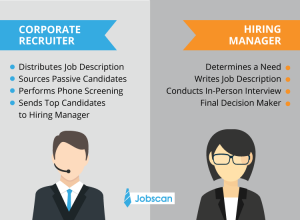Over the past few years, there’s been a lot of talk about the “6-second rule” after the Ladders showed that recruiters skim a resume for an average of 6 seconds before making a decision. Then, applicant tracking systems (ATS) and their automated scores and filters entered into the mix, causing job seekers to chase their tails on the hunt for the right resume writing strategy.
The key is learning how your information may be interpreted by both the ATS and the human reader.
As a former corporate recruiter with 15 years of experience in nonprofit, banking, and manufacturing industries, I’ve used several different ATS to review, parse, and reject resumes. Here’s a little secret: not all companies use automated scoring as a method for screening resumes.
There is no one way to read a resume
Several different factors go into how your resume is interpreted by the reader– a recruiter, hiring manager, or both.
Volume of applications is one determining factor in the length of time a hiring representative has to dedicate to actually reading a resume. For any given vacancy, I would easily review upwards of 100+ resumes, which didn’t leave a lot of time for reading resumes word for word.
Many of these resumes were skimmed via a mobile device as I waited for lunch or binged on reality TV before winding down for some shut-eye. After years in the recruiting industry, I learned that hiring managers often spent quite a bit longer reviewing an ideal candidate’s resume than a recruiter.

Grabbing the recruiter’s attention at the first touch is the goal.
How I decided which resumes made the cut
Here’s a peek into what I looked for when reviewing resumes.
First-glance method
Upon opening the resume, I often made a split decision concerning a job seeker’s candidacy.
I paid close attention to the candidate’s contact information. I needed to know who I could be speaking with, their location, and how quickly I could reach them (via phone or email, etc.).
Location was a deal breaker for certain positions since familiarity with the territory was crucial to an employee’s success. I urge job seekers to stop right now and proofread your contact info. Don’t miss opportunities because you’ve transposed your phone number.
If you’re a career changer, willing to relocate, or have an employment gap, you’ll especially want to include a cover letter. Recruiters may refer to cover letters to uncover more about the candidate’s career story.
As a candidate, your job is to make the recruiter’s job easier. Grab this person’s attention and lead their eyes to the quality information necessary to determine your fit for the role.
When this information was nicely formatted with bolding or shading, it influenced me to spend more time reviewing the document.
I’d then do a quick scan to assess the resume length. Anything longer than 2 pages and containing wall-to-wall text, jumbled design techniques, or functional formatting didn’t make it far. Functional resumes aren’t totally a negative but many times, they raise more concerns than they resolve.
Someone in career transition may be tempted to use a functional format, and in many cases, there can be a positive outcome. However, job seekers must keep in mind that functional resumes force recruiters to piece together which skills or achievements correlate with what job — and it’s not always simple to gauge how much experience a candidate has from a bulleted list of competencies.
Functional resumes also don’t fare well with the ATS. If at all possible, opt for drawing a parallel between your transferable skills and the requirements in the job posting instead.
As for length, your resume is your career brochure, not your autobiography. Reel the hiring representatives in with your relevant career synopsis and stay on task with the focus of the job posting.
Your resume is your career brochure,
not your autobiography.
Ashley Watkins
Key requirements
After the first glance of a resume, I soaked in the details of “the top third” of the resume. This space on your resume is prime real estate. Be sure to make this portion of your resume keyword-rich, high-impact, and ready to sell. Objective statements are a thing of the past so your career summary should clearly communicate who you are, what you do, and how you add value to the team or organization.
From there, I evaluated whether a candidate met the qualifications. I verified fit through education, licenses, certifications, and job titles.
Even if you haven’t completed your degree or certification, add it to your resume and list an expected completion date. At some point, you’ll cross paths with a hiring manager willing to make an exception and hire you under the stipulation that you have this must-have requirement completed at a certain point after your hire date.
Relevant job titles offer bonus points too. If a past title doesn’t match the posting but your job function is spot on, consider using a slash title (Outside Sales/Operations Manager) to better explain the scope of what you did and emphasize relevant keywords.
Check to see if you have the right keywords and titles in your resume right here:
Association memberships, industry awards, and community involvement were also nice touches to include on your resume.
Include accomplishments
Next, I wanted to see quantifiable achievements. This didn’t always mean numbers. View your achievement bullets as selling points to guide the interview discussion.
Recruiters will look for examples of how you’ve saved money, repaired declining relationships, or increased revenue. By listing high-impact accomplishments, you can quickly demonstrate your contribution to bottom-line results. When candidates did this successfully, I already had an idea of potential salary offer amounts, fit with company culture, and a strategy for selling this candidate to my hiring team.
Disqualifiers
In case you haven’t figured it out by now, the recruiter’s job is to rule you out, not into, consideration. Quite a bit of time will be spent narrowing down a pool of resumes, so recruiters can only present the best-qualified slate of candidates to the hiring manager.
The recruiter’s job is to rule you out, not in.
Ashley Watkins
Certain red flags are a surefire way to land yourself into the no pile, including omitting dates, having excessive employment gaps, or frequent job changes.
Whenever I received a resume with no employment dates or location, I immediately felt as though the applicant was hiding something. I’d share my concerns with the hiring team and was advised on many occasions to move forward with interviews. It never failed that upon further investigation, the candidate would have some out-of-this-world interview story to tell which yielded a rejection letter shortly after that.
Attempting to camouflage dates by using the years-only format won’t always work. By using the years-only format, you can add some time onto your short-lived job stint or take away valuable credit for your job history. For example, if you worked somewhere from January 2005 until December 2006 and you’ve used the years-only format (2005-2006), it appears that you have 1 year of experience when you really have 2 years.
To ensure ATS compatibility, use the month-year format for your dates.
As stated previously, explain employment gaps in your cover letter. When possible, fill the gaps by listing volunteer roles, student responsibilities, or consulting work on the resume to keep the recruiter’s eyes on the resume as long as possible to eliminate the need to stop and refer to the cover letter for answers.
The extras
You would think it goes without saying but grammar and spelling errors have been and always will be big turn-offs. Be sure to proofread every line in your documents before submitting. I would suggest having someone else give your information a second look. When you’ve reviewed the same information repeatedly, it’s easy to see what should be there and not what’s actually there.
Most job seekers don’t consider an email address as an obstacle. However, using an AOL, Yahoo, or cable/internet provider email address can give the impression that you’re outdated or not as tech-savvy as the potential employer desires. Also, some older email service providers have subpar spam filters. I can’t tell you how many applicants were furious about not being selected to interview for my open positions, only to find out they’d never responded to several emails I’d sent them concerning completing assessments.
Stick with Gmail, Outlook, iCloud, or an email connected to your personal domain. Also, if you haven’t personalized your LinkedIn URL, now would be a good time to add another layer of professionalism.
Related articles:
- What Do Corporate Recruiters Want? We Asked Them
- The Only Way Recruiters Will Find You on LinkedIn
- Ask Recruiters: How to Nail Your Email Responses and Phone Interview

She can be found on Facebook, Twitter, Instagram, LinkedIn or via www.WriteStepResumes.com.

















